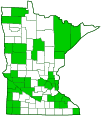Yellow-collared scape moth
(Cisseps fulvicollis)
Conservation • Description • Habitat • Ecology • Distribution • Taxonomy
| Hodges # | 8267 |
||
Conservation Status |
|||
| IUCN Red List | not listed |
||
| NatureServe | NNR - Unranked |
||
| Minnesota | not listed |
||
Description |
Yellow-collared scape moth is a small to medium-sized, day flying, wasp-mimic, tiger moth. It occurs across North America from east coast to the west coast and from Texas to the Northwest Territories. Adults are ⅝″ to ¾″ (16 to 20 mm) in length and have a 1⅛″ to 1 7 ⁄16″ (29 to 37 mm) wingspan. They look superficially similar to the closely related Virginia ctenucha but are smaller and narrower. The head is black. The antennae are black and feather-like, with branches only on one side of most segments. The basal segment (scape) is long. The thorax is black or dark brown. There are brightly colored scales on the first section of the thorax (prothorax) forming a broad collar that extends across the upper (dorsal) surface and down the sides. The scales are orange on most individuals, orangish-yellow or yellow on others. The abdomen is black and often has a metallic blue iridescence. The forewings are dark brown to blackish-brown, long, and narrow. The hindwings are smaller, black around the edges, grayish-white and translucent with black veins in the middle. They are hidden when the moth is perched. The caterpillar is up to 1 3 ⁄16″ (3 cm) long. The thorax and abdomen are yellow with a black stripe down the middle (middorsal), a broad black stripe on each side, and a narrow brownish-orange stripe in the subdorsal area and in the subspiracular area. The head is pale brownish-orange, and shiny. On most caterpillars,there is a dark line across the face or dark markings around the eyes. The body is mostly hidden beneath dense tufts of long, stiff, dirty white hairs (seta). The setae rise from circular warts that are not colored. The warts on the second and third thoracic segment (T2 and T3) and on the ninth abdominal segment (A9) are enlarged and oval. The front and back parts of the body also have longer darker hairs. The abdominal leg-like structures (prolegs) are pale. |
Size |
Total length: ⅝″ to ¾″ (16 to 20 mm) Wingspan: 1⅛″ to 1 7 ⁄16″ (29 to 37 mm) |
Similar Species |
Habitat |
Wet meadows and prairies, old fields |
Ecology |
Season |
Probably two generations; June to September |
Behavior |
Adults are active during the day. They are attracted to ultraviolet light. Caterpillars feed close to the ground at night and are rarely seen. |
Life Cycle |
The cocoon is formed mostly from body hairs. |
Larva Hosts |
Grasses and sedges |
Adult Food |
Nectar of flowers, especially goldenrods |
Distribution |
||
|
Sources 7, 21, 24, 27, 29, 30, 71, 75, 82, 83. Biodiversity occurrence data published by: Minnesota Biodiversity Atlas (accessed through the Minnesota Biodiversity Atlas Portal, bellatlas.umn.edu, 9/25/2025). |
|
| 9/25/2025 | ||
Occurrence |
||
Widespread; not common but sometimes locally abundant |
||
Taxonomy |
|
Order |
|
Superfamily |
Noctuoidea (Owlet Moths and Allies) |
Family |
Erebidae (Underwing, Tiger, Tussock, and Allied Moths) |
Subfamily |
Arctiinae (tiger moths and allies) |
Tribe |
Arctiini (tiger moths) |
Subtribe |
Ctenuchina (handmaidens) |
Genus |
Cisseps |
In 2011 the family Arctiidae (tiger moths and lichen moths) was transferred to the family Erebidae mostly intact but demoted to a subfamily. The former subfamilies are now tribes, the former tribes now subtribes. |
|
Subordinate Taxa |
|
|
|
Synonyms |
|
Cisseps packardii Cisseps pallens Cisseps semidiaphana Cisseps wrightii Scepsis fulvicollis Scepsis matthewi Scepsis packardii |
|
Common Names |
|
yellow-collared scape moth The name scape moth refers to the long basal segment of the antennae (scape) on members of this genus. The term “yellow-collared” is a misnomer, since most individuals have an orange collar. |
|
Glossary
Collar
In grasses: The area on the back of a grass leaf at the junction of the sheath and the blade. On moths: the upperside of the prothorax.
Costa
In plants: The central axis of a pinna, to which pinnules are attached. In Lepidoptera: The leading edge of the forewing.
Proleg
A fleshy structure on the abdomen of some insect larvae that functions as a leg, but lacks the five segments of a true insect leg.
Collar
In grasses: The area on the back of a grass leaf at the junction of the sheath and the blade. On moths: the upperside of the prothorax.
Scape
In plants: An erect, leafless stalk growing from the rootstock and supporting a flower or a flower cluster. In insects: The basal segment of the antenna.
Seta
A stiff, hair-like process on the outer surface of an organism. In Lepidoptera: A usually rigid bristle- or hair-like outgrowth used to sense touch. In mosses: The stalk supporting a spore-bearing capsule and supplying it with nutrients. Plural: setae. Adjective: setose.
Spiracle
A small opening on the surface of an insect or arachnid through which it breathes.
Visitor Photos
Share your photo of this insect.
This button not working for you?
Simply email us at info@MinnesotaSeasons.com.
Attach one or more photos and, if you like, a caption.
Alfredo Colon |
||
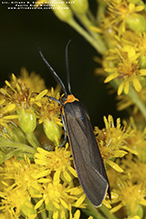 |
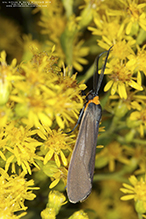 |
|
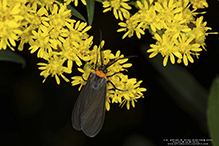 |
 |
|
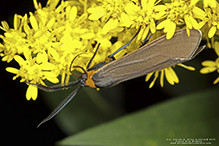 |
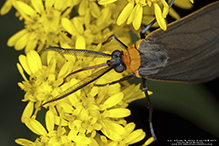 |
|
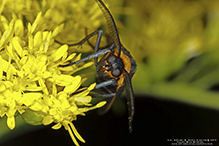 |
||
Lynn Rubey |
||
 |
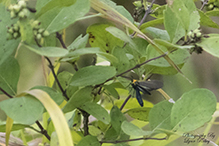 |
|
A Yellow-collared Scape Moth in flight in The Big Stone National Wildlife Refuge. |
||
|
||
A Yellow-collared Scape Moth in The Big Stone National Wildlife Refuge as it landed on a leaf. |
|
|
Luciearl |
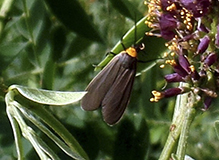 |
MinnesotaSeasons.com Photos
|

Slideshows

Visitor Videos
Share your video of this insect.
This button not working for you?
Simply email us at info@MinnesotaSeasons.com.
Attach a video, a YouTube link, or a cloud storage link.
Other Videos
Cisseps fulvicollis = YELLOW-COLLARED SCAPE MOTH
Rob Curtis
Yellow-collared scape moth drinking nectar in flowers
GoTrails

Visitor Sightings
Report a sighting of this insect.
This button not working for you?
Simply email us at info@MinnesotaSeasons.com.
Be sure to include a location.
Lynn Rubey
8/13/2019
Location: Big Stone National Wildlife Refuge
A Yellow-collared Scape Moth in The Big Stone National Wildlife Refuge as it landed on a leaf.
MinnesotaSeasons.com Sightings

